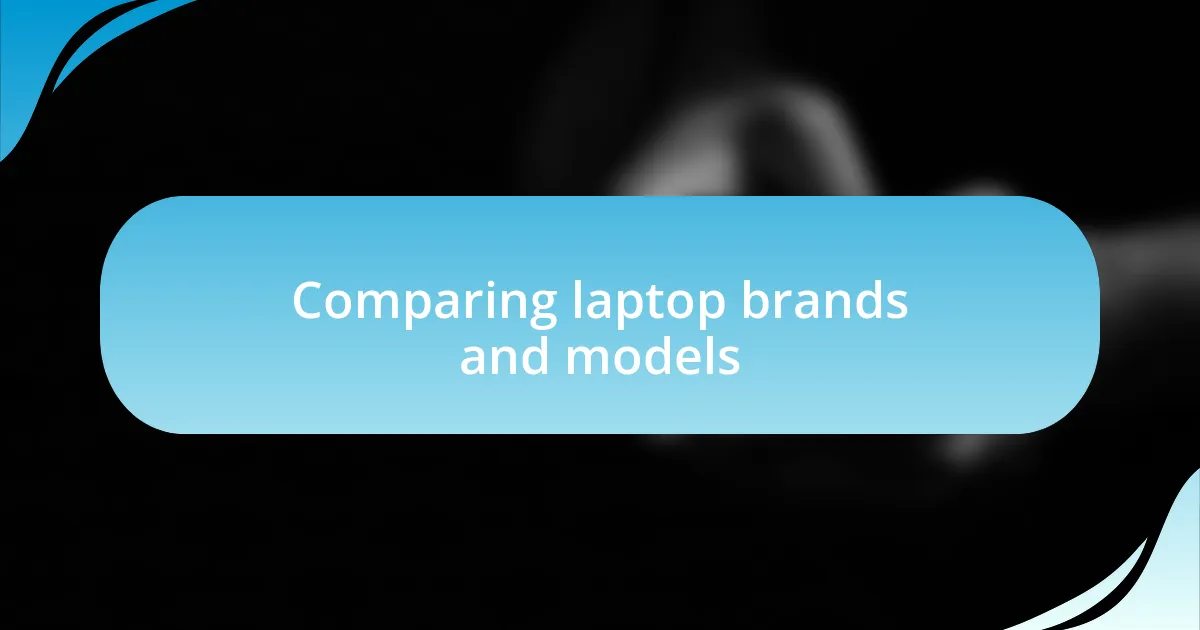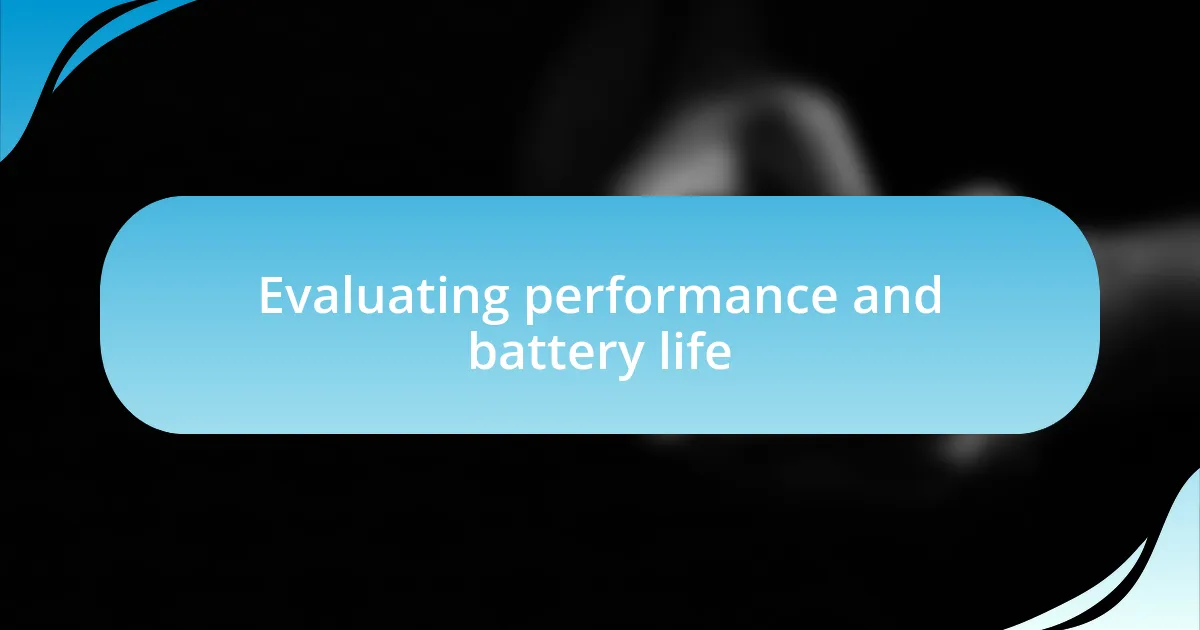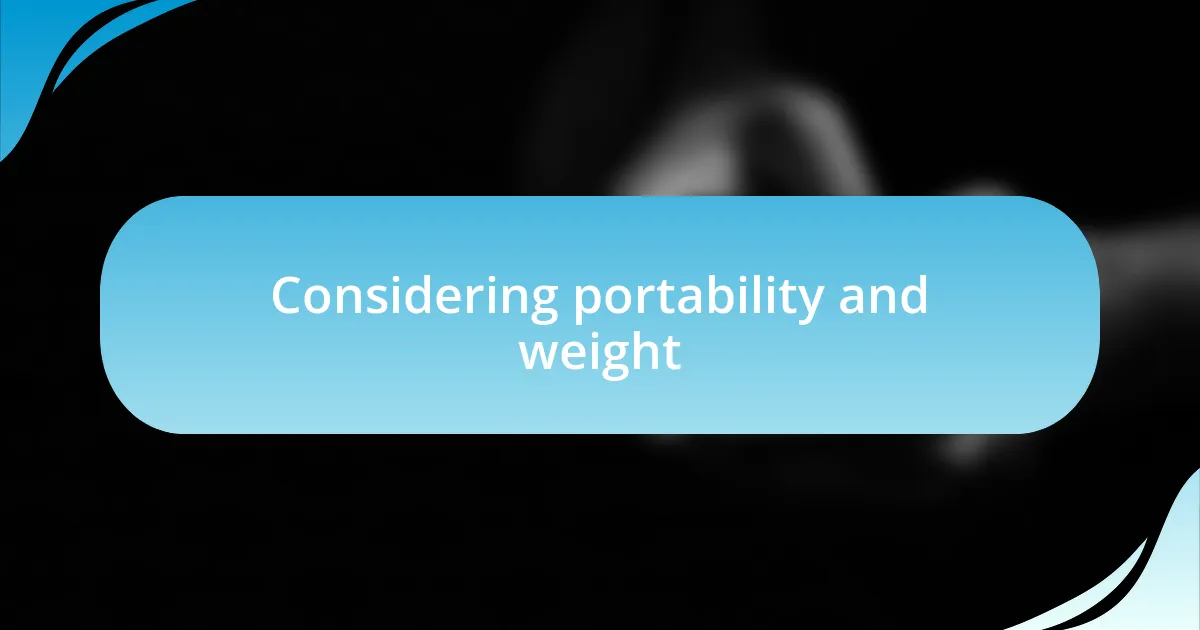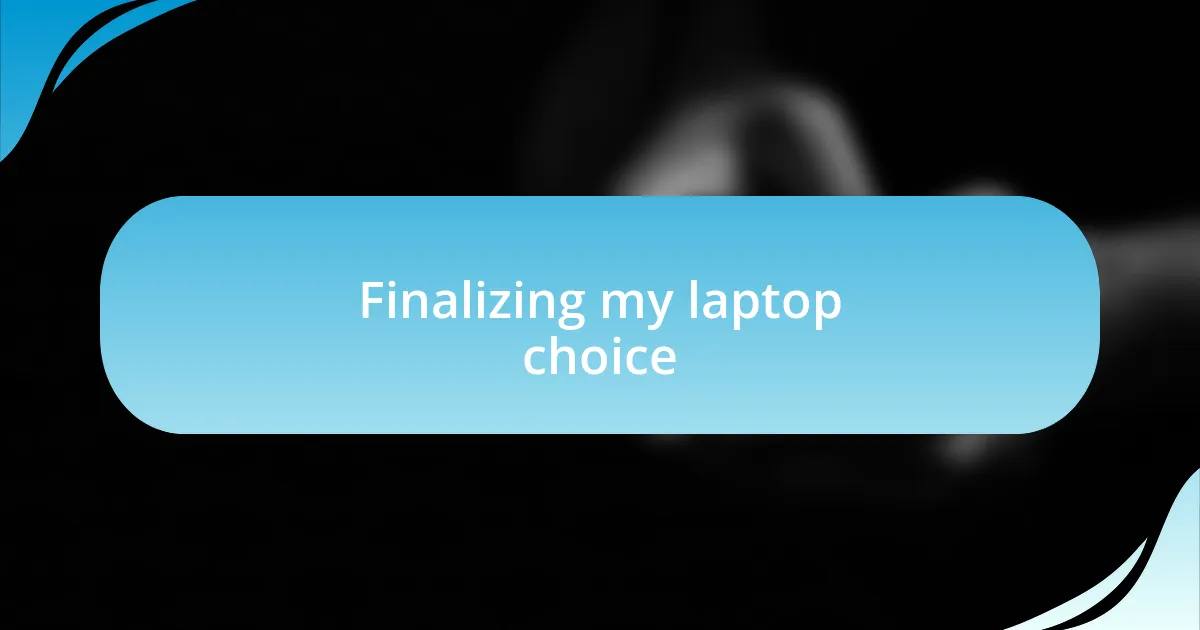Key takeaways:
- Identified the importance of specifications such as processor, RAM, battery life, and storage for fulfilling specific needs as a freelance writer.
- Evaluated different laptop models and brands, realizing personal preferences greatly influenced satisfaction and usability.
- Emphasized the significance of portability and weight, opting for a lightweight laptop to enhance mobility and convenience during work.
- Finalized the choice by ensuring the laptop felt like an extension of creativity and productivity, highlighting the personal connection in the decision-making process.

Understanding my laptop needs
Understanding my laptop needs was a journey that ultimately revolved around how I intended to use it. I remember standing in an electronics store, feeling overwhelmed by the array of options and specifications. It hit me then: “What do I really need this device to do?”
One of the defining moments was reflecting on my daily routine. I realized that, as a freelance writer, my laptop had to handle intense word processing and multitasking with ease. Think about it—how frustrating would it be to have a device that lags during a tight deadline? I found myself imagining the stress of losing precious moments to loading screens.
In evaluating my needs, I also considered portability and battery life. There were times when I’d work at a coffee shop, and the last thing I wanted was to be tethered to a power outlet. I cherished those sunny afternoons spent outside, typing away, completely free from charging anxiety. I learned that a laptop wasn’t just a tool; it was an extension of my lifestyle.

Researching laptop specifications
Researching laptop specifications was an eye-opening experience for me. At first, I was lost in the sea of numbers and jargon—RAM, processor speed, screen resolutions. It was like learning a new language, but I quickly realized how crucial these specifications were to my laptop’s performance. I spent countless hours reading online reviews and comparing models, trying to decipher which options would truly meet my needs.
When diving into the specifics, I paid close attention to several key features:
- Processor: I learned that a powerful processor makes multitasking smoother, especially when running multiple applications.
- RAM: More RAM means better performance, which is critical for my writing and research work.
- Battery Life: I found that a longer battery life allowed me to work freely without constantly hunting for outlets.
- Storage: Deciding between SSD and HDD was vital; SSDs are faster but often smaller, while HDDs provide more space at a slower pace.
- Display Quality: A clear, vibrant screen made reading and editing much more enjoyable.
With a better understanding of these specifications, I felt more empowered to make a choice that truly resonated with my lifestyle. Each time I compared different models, I could almost visualize how my work would flow, feeling a renewed sense of excitement about finding the right laptop.

Comparing laptop brands and models
When I started comparing laptop brands and models, I found myself gravitating towards a few well-known names. Each brand had its own unique strengths, but I learned that not every popular option was the best for me personally. For instance, while Dell was praised for its robust build quality and customer service, I noticed that Apple laptops offered a seamless ecosystem for my needs. Diving deeper, I evaluated the user experiences on various forums, and personal stories from users often highlighted the little details that could significantly impact satisfaction.
As I delved into specific models, I began to appreciate how even minor differences could make a huge difference in daily use. For example, the difference between a laptop with a matte display versus a glossy one was particularly telling—each type impacted how glare affected my work outdoors. My experiences using friends’ laptops also fueled my decision-making. While I appreciated the sleek design of a MacBook, it was clear that a Lenovo ThinkPad was more in line with my typing preferences, especially for long writing sessions.
Ultimately, establishing a comparison table helped me visualize my options more clearly and weigh the pros and cons. By laying out essential features side by side, I was able to clarify my priorities in terms of performance, aesthetics, and usability. In this way, I could understand how each model aligned with my lifestyle and how it could enhance my daily work routine.
| Brand | Key Features |
|---|---|
| Dell | Robust build, excellent customer service |
| Apple | Sleek design, seamless ecosystem |
| Lenovo | Comfortable keyboard, great for long typing sessions |
| HP | Good battery life, affordable options |

Evaluating performance and battery life
Evaluating performance and battery life was crucial in my quest for the ideal laptop. My specific needs required a machine that could handle multitasking, especially since I often work on several applications simultaneously. I remember testing a friend’s high-performance gaming laptop—though it boasted impressive speed, the fan noise was distracting during quiet working hours, making me rethink the kind of performance I truly needed.
Battery life also played a significant role in my decision-making. I once found myself in a coffee shop, frantically searching for an outlet as my laptop sputtered to a close after just a couple of hours. That moment taught me the value of a long-lasting battery. In my research, I discovered that laptops like the HP Spectre stood out for their exceptional battery performance, which resonated with my desire for portability and freedom from constant charging.
As I compared specifications, I focused on factors like processor types and RAM, seeking the right balance for my daily tasks. I learned that a mid-range processor paired with sufficient RAM could boost my productivity without being overkill, which ultimately allowed me to find an option that fit both my performance expectations and battery life preferences without breaking the bank. So, how much power do you really need? For me, it was about finding that sweet spot where efficiency met endurance.

Considering portability and weight
When I started exploring laptops, weight became a significant factor in my decision. I remember my first college experience, lugging around a hefty laptop in my backpack, which left my shoulders sore by the end of the day. This made me realize that opting for a lightweight model would make all the difference, especially when I wanted to work from the park or coffee shops.
Portability isn’t just about weight, though. It’s about how easily I could transfer my laptop from one space to another. During my search, I conducted a hands-on test, carrying different models around the store. I quickly found that a sleek ultrabook felt almost weightless in my hands, making it a top contender. I thought to myself, how often do I really want to feel the strain of a heavy laptop? For frequent travelers or commuters, the right choice can genuinely enhance your experience.
Ultimately, I learned that selecting a portable laptop isn’t just a matter of convenience; it’s about freedom. Imagine being able to set up your workspace anywhere—be it a cozy café or a bustling airport. I wanted a device that wouldn’t anchor me down, and that realization guided my final decision into a model that balanced portability and performance perfectly.

Finalizing my laptop choice
When it came time to finalize my laptop choice, I felt a wave of excitement mixed with anxiety. I had narrowed down my options and spent hours researching specifications, but I wanted to ensure that the laptop truly resonated with my daily needs. As I looked at each model, I asked myself, which one feels like an extension of my creativity and productivity?
After testing a few contenders, I found myself gravitating towards a particular ultrabook that not only matched my requirements but also sparked joy when I opened it. The sleek design and vibrant display drew me in. It reminded me of the feeling I had when I first unboxed my first tech gadget years ago—the thrill of potential waiting to be unleashed. Was this the feeling I should trust when making my final decision?
That moment of recognition was pivotal. I realized that finalizing my laptop choice wasn’t simply about specs or weight; it had to feel right. I considered my unique workflow and the moments I’d spend with it—whether working on projects late into the night or streaming shows on weekends. Ultimately, I chose the laptop that not only checked all the boxes but also connected with me on a personal level, making it feel like it was meant to be mine.
















